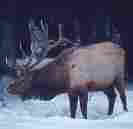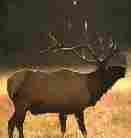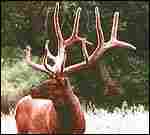
deer
Wild Animals
alligators
baboons
bears
chimpanzees
crocodiles
deer
dolphins
elephants
foxes
giraffes
gorillas
leopards
lions
seals
sharks
snakes
tigers
whales
wolves
zebras
Pets
dogs
cats
fish
birds
|
This site provides you with the information about deer, deer information online, deer pictures online, deer photos, deer pics for kids, images of deer, deer description, free deer info, and more.
If you think that this site is helpful, please recommend your friends to visit our site.
deer
Deer, common name for certain hoofed, artiodactylmammals, usually characterized by bony, often branching antlers that are shed and regenerated annually. Deer range through the Americas, Europe, Asia, and North Africa. The largest populations occur in mixed wooded and open land, although deer also live in swamps, on mountains, and on northern tundras. Deer species range in size from the European elk, or moose (see Elk), which may reach a shoulder height of 2.35 m (7.7 ft), to the South American pudu, which can be as little as 25 cm (10 in) high at the shoulder. The first deer appeared in the early Oligocene epoch in Asia, about 38 million years ago.
II CHARACTERISTICS
Deer commonly have lithe, compact bodies and long, powerful legs suited for rugged woodland terrain. They are also excellent swimmers. Their lower cheek teeth have crescent ridges of enamel, which enable them to grind a wide variety of vegetation. The animals are ruminants, or cud chewers, and have a four-chambered stomach. Nearly all deer have a facial gland, in front of each eye, that contains a strongly scented substance, or pheromone, used to mark its home range. The males of many species open these glands wide when angry or excited. All deer except the musk deer have a liver without a gallbladder. The musk deer, along with the Chinese water deer, also differs from other species in that it has no antlers and bears upper canines that have developed into tusks.
III ANTLERS
Unlike the hollow, permanent horns of other ruminants, the antlers of deer are solid and bony. Except in the caribou, antlers form only on males and their growth is controlled by the male sex hormone. Arising from the frontal bones and nourished by a highly vascularized, fine-haired skin, called velvet, antlers complete their growth, which requires great amounts of calcium, within a few months. Circulation is then cut off, and the resulting dead skin is sloughed off as the animal rubs its antlers against trees. Antlers are used to slash territorial markings on trees or bushes, to make threatening displays, and to combat other males. Usually the fighting is stylized and harmless, but occasionally males of large species lock antlers and die of exhaustion or starvation. Moose antlers reach a width of 1.8 m (6 ft) and a weight of 20 kg (44 lb); those of an extinct giant fallow deer spread more than 3 m (more than 10 ft). Antlers in a given species may vary in size from one population to another, depending on the quality and quantity of food. In overpopulated areas that are heavily browsed, the deer usually have small antlers.
IV BEHAVIOR
Many deer species group into families around the female, with the male often becoming solitary; others, such as the musk deer and Chinese water deer, live mainly in pairs. The red deer, which are gregarious, associate in small to large herds, each led by a mature female. Caribou migrate between the forest and the treeless tundra in herds of a thousand or more.
Deer forage on twigs, leaves, bark, and buds of bushes and saplings and on grasses and other plants, feeding most actively at twilight. The female gives birth once a year, usually to one or two fawns. The gestation period lasts from 160 days in musk deer to ten months in roe deer; this long gestation in roe deer is accounted for by a delayed implantation. Fawns are kept hidden in thickets, camouflaged by their usually dappled markings. In the United States, where deer now have few natural predators, they often overbrowse their territory and may die of starvation, especially during winters of deep snow. Hunting seasons are adjusted accordingly.
V KINDS AND IMPORTANCE
The white-tailed deer, or Virginia deer, with tined antlers and a tail with a prominent white underside, is found in most parts of the United States as well as from Alaska to Bolivia. The mule deer and the black-tailed deer, now considered of the same species as mule deer, are confined to the western United States. The American elk, or wapiti, of southern Canada and the northern United States is called red deer in Europe and Asia. The moose ranges through northern North America; in northern Europe it is known as elk. See also Fallow Deer; Muntjac; Sambar.
Musk, which comes from a gland on the abdomen of the musk deer, is used in medicines and perfumes. Deerskin is used for shoes, boots, and gloves, and antlers are made into buttons and knife handles. Deer are hunted for sport and for their meat, which is called venison.
The Saami of Scandinavia and the Kola Peninsula of Russia and other nomadic peoples of northern Asia use reindeer for food, clothing, and transport. The caribou, a reindeer variant in North America, is not domesticated or herded as is the case in Europe but is nevertheless important to the Inuit. Most commercial venison in the United States is imported from New Zealand. Deer were originally brought there by European settlers, and the deer population rose rapidly, causing great environmental damage. They were controlled by hunting and poisoning until the concept of deer farming arose in the 1960s. Deer farms in New Zealand number more than 3500, with more than 400,000 deer in all.
Scientific classification: Deer make up the family Cervidae of the order Artiodactyla. The European elk, or moose, is classified as Alces alces. South American pudus make up the genus Pudu, and musk deer the genus Moschus. The Chinese water deer is classified as Hydropotes inermis, and the caribou, or reindeer, as Rangifer tarandus. The red deer make up the genus Cervus, and the roe deer the genus Capreolus. The white-tailed deer, or Virginia deer, is classified as Odocoileus virginianus; the mule, or black-tailed, deer as Odocoileus hemionus; and the American elk, or wapiti, as Cervus elaphus.




|